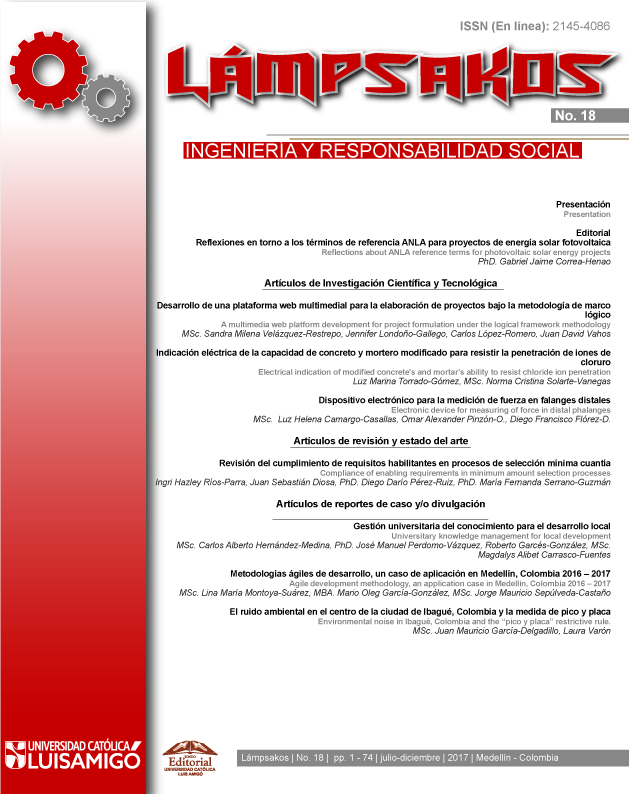Electrical Indication of Modified Concrete´s and Mortar´s Ability Resist Chloride Ion Penetration
DOI:
https://doi.org/10.21501/21454086.2358Keywords:
Concrete, Chloride ion, mortar, permeability.Abstract
This article describes the ability of concrete and mortar mixtures with different fly ash contents to resist chloride ion penetration 14 and 28 days after casting. The Rapid Chloride Permeability Test (RCPT) in accordance to the norm ASTM C1202 was used in order to obtain qualitative indications of the chloride ion penetrability depending on the electrical conductance of concrete respectively mortar samples. Furthermore, the Automatic Concrete Water Permeability Apparatus at Four Cells C430X from Matest was used to measure the water permeability 28 days after casting. Finally, the uniaxial compressive strength was measured 28 days after casting. The following conclusions can be made. The results of the Chloride Permeability Test (RCPT) did not show a clear correlation between the ash content, the a/c ratio and the Chloride Ion Penetrability. However, the chloride diffusion coefficient for the hormone and mortar at 28 days tends to increase with increasing a / c ratio and decreases with the age of hydration. As for permeability, an increase in the permeability was found at 28 days of age with an increasing ratio of a/c ratio.
Downloads
References
J. Bijen, “Benefits of slag and fly ash,” Constr. Build. Mater., vol. 10, no. 5 SPEC. ISS., pp. 309–314, 1996. http://dx.doi.org/ 10.1016/0950-0618(95)00014-3
S. Antiohos, K. Maganari, and S. Tsimas, “Evaluation of blends of high and low calcium fly ashes for use as supplementary cementing materials,” Cem. Concr. Compos., vol. 27, no. 3, pp. 349–356, 2005. http://dx.doi.org/10.1016/j.cemconcomp.2004.05.001
S. Ahmad, “Reinforcement corrosion in concrete structures, its monitoring and service life prediction - A review,” Cem. Concr. Compos., vol. 25, no. 4–5 SPEC, pp. 459–471, 2003. http://dx.doi.org/ 10.1016/50958-9465(02)00086-0
T. R. Naik, “Chloride Ion Penetration Test, Carbonation Depth test and Salt Scaling Test,” Rilem, no. August, pp. 1–9, 2004. https://www4.uwm.edu/cbu/Papers/2004%20CBU%20Reports/REP-566.pdf
M. D. A. Thomas, “Optimizing the Use of Fly Ash in Concrete,” Portl. Cem. Assoc., p. 24, 2007. http://dx.doi.org/ 10.1016/0950-0618(95)00014-3
C.-C. Yang, Y.-S. Yang, and R. Huang, “The effect of aggregate volume ratio on the elastic modulus and compressive strength of lightweight concrete,” Journal of MarineScience and Technology. 1997. http://jmst.ntou.edu.tw/marine/5/31-38.pdf
Dhir, R.K. and Hewlett, P.C. Concrete Durability and Repair Technology. Proceedings of The International Seminar Held at The University of Dundee, Scotland, United Kingdom. https://books.google.com.co/books?hl=es&lr=&id=JueMm00Odn0C&oi=fnd&pg=PR1&dq=Dhir,+R.K.+and+Hewlett,+P.C.+Concrete+Durability+and+Repair+Technology.+Proceedings+of+The+International+Seminar+Held+at+The+University+of+Dundee,+Scotland,+United+Kingdom.&ots=ICr4HS70Jj&sig=Kbz-y5EcbFIwh3mLbV8tPwtsutI#v=onepage&q&f=false
K. S. Chia and M. H. Zhang, “Water permeability and chloride penetrability of high-strength lightweight aggregate concrete,” Cem. Concr. Res., vol. 32, no. 4, pp. 639–645, 2002. http://dx.doi.org/10.1016/S0008-8846(01)00738-4
Controls Group. Water permeability apparatus. http://www.controls-group.com/eng/concrete-testing-equipment/water-permeability-apparatus.php
C. C. T. Speci-, T. D. Cores, C. C. T. Speci-, B. Statements, and C. Testing, “Standard Test Method for Compressive Strength of Cylindrical Concrete Specimens ASTM C39M-37,” vol. 4, no. March, pp. 1–5, 2001. http://dx.doi.org /10.1520/C0039_C0039M-17B
E. C. Nacional, R. Calzada, and A. Azul, “Norma técnica guatemalteca ASTM C-109,” no. 502, 2013. https://conred.gob.gt/site/normas/NRD3/1_CEMENTO/2_NORMA_NTG_41003h4_ASTM_c109-c109m-11_b.pdf
R. Siddique, “Effect of fine aggregate replacement with Class F fly ash on the abrasion resistance of concrete. Cement and Concrete Research,” Cem. Concr. Res., vol. 33, no. 11, pp. 1877–1881, 2003. https://doi.org/10.1016/S0008-8846(02)01000-1
E. A. Kaur, “Strength and Duriabilty Properties of Concrete with Partial Replacement of Cement with Metakaolin and Marble Dust,” vol. 4, no. 7, pp. 1032–1035, 2015. http://www.kresttechnology.com/krest-academic-projects/krest-mtech-projects/Civil/Civil%20M.tech%20Projects%202017%20-2018/2.%20Concrete%20Projects/BASE%20PAPERS/26.%20Strength%20and%20durability%20study%20of%20metakaoline.pdf
B. S. Mohammed, K. M. A. Hossain, and W. L. Foo, “Rapid Chloride Permeability Test on Lightweight Concrete Made with Oil Palm Clinker,” vol. 1, no. 4, pp. 1863–1870, 1870. https://pdfs.semanticscholar.org/4cac/7e57f25b86722d0898a179c90e8450fd7e6a.pdf
and S. J. K. Y. Y. Kim, K. M. Lee, J.W. Bang, “Effect of W/C ratio on durability and porosity in cementmortar with constant cement amount,” Adv. inMaterials Sci. Eng., vol. 2014, 2014.http://dx.doi.org/10.1155/2014/273460.
Downloads
Additional Files
Published
How to Cite
Issue
Section
License
In accordance with national and international copyrights, as well as publishing policies of "Fundación Universitaria Luis Amigó" and its Journal "Lámpsakos" (indexed with ISSN : 2145-4086), I (we ) hereby manifest:1. The desire to participate as writers and submit to the rules established by the magazine publishers.
2. The commitment not to withdraw the manuscript until the journal finishes the editing process of the ongoing issue.
3. That article is original and unpublished and has not been nominated or submitted together in another magazine; therefore, the rights of the article in evaluation have not been assigned in advance and they do not weigh any lien or limitation for use.
4. The absence of conflict of interest with commercial institution or association of any kind
5. The incorporation of the quotes and references from other authors, tending to avoid plagiarism. Accordingly, the author affirms that the paper being published do not violate copyright, intellectual property or privacy rights of third parties. Morover, if necessary there is a way of demonstrating the respective permits original copyright to the aspects or elements taken from other documents such as texts of more than 500 words, tables, graphs, among others. In the event of any claim or action by a third party regarding copyright on the article, the author (s) will assume full responsibility and come out in defense of the rights herein assigned. Therefore, for all purposes, the Journal "Lámpsakos" of the "Fundación Universitaria Luis Amigó" acts as a third party in good faith.
6. In the event of the publication of the article, the authors free of charge and on an exclusive basis the integrity of the economic rights and the right to print, reprint and reproduction in any form and medium, without any limitation as to territory is concerned, in favor of the Journal "Lámpsakos" of the "Fundación Universitaria Luis Amigó".








